We’ve been keeping an eye on the Framework laptop over the past two years – back in 2021, they announced a vision for a repairable and hacker-friendly laptop based on the x86 architecture. They’re not claiming to be either open-source or libre hardware, but despite that, they have very much delivered on repairability and fostered a hacker community around the laptop, while sticking to pretty ambitious standards for building upgradable hardware that lasts.
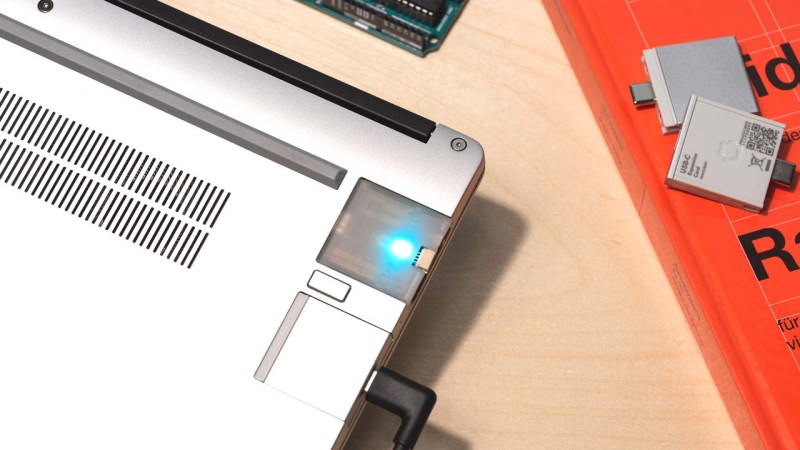
I’ve long had a passion for laptop hardware, and when Hackaday covered Framework announcing the motherboards-for-makers program, I submitted my application, then dove into the ecosystem and started poking at the hardware internals every now and then. A year has passed since then, and I’ve been using a Framework as a daily driver, reading the forums on the regular, hanging out in the Discord server, and even developed a few Framework accessories along the way. I’d like to talk about what I’ve seen unfold in this ecosystem, both from Framework and the hackers that joined their effort, because I feel like we have something to learn from it.
If you have a hacker mindset, you might be wondering – just how much is there to hack on? And, if you have a business mindset, you might be wondering – how much can a consumer-oriented tech company achieve by creating a hacker-friendly environment? Today, I’d like to give you some insights and show cool things I’ve seen happen as an involved observer, as well as highlight the path that Framework is embarking upon with its new Framework 16.
As Community Expands, So Do The Options
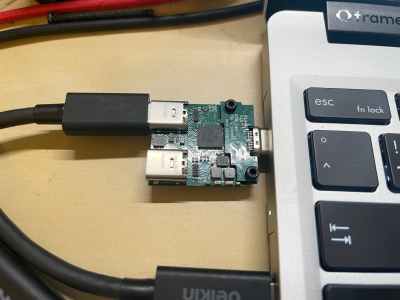 One of the selling points of a Framework laptop is that none of its external ports are set in stone – instead, it has USB-C-based slots for cards that can have various ports on them. This doesn’t give you more ports than the usual, maybe even less depending on which cards you get, but it does give you more flexibility in what ports you give yourself.
One of the selling points of a Framework laptop is that none of its external ports are set in stone – instead, it has USB-C-based slots for cards that can have various ports on them. This doesn’t give you more ports than the usual, maybe even less depending on which cards you get, but it does give you more flexibility in what ports you give yourself.
Maybe you prefer three external displays and a Thunderbolt dock, maybe you want three USB-A ports, or maybe you want to go full USB-C – whatever combination you’d like to use day to day, you can likely combine a few cards and get there. The “Expansion Card” standard also opens the door for third-party cards – cards that someone else has designed, either a hacker or Framework themselves in the future, or maybe even cards that you might want to design for your own use. In particular, Framework has published KiCad PCB files and 3D case drawings, keeps a separate forum area for expansion card development, and even gives more targeted support to individual hackers prototyping their own Expansion Cards.
Over the two years, we’ve seen a ton of expansion card ideas, mockups, designs and actual hardware. I’d estimate that out of all the expansion card ideas, 50% of them have stayed in the idea realm, 40% have been designed but never built, and 10% have been built and become available to users. The 10% include cards like UART, CAN and RS485 expansion cards, a Solo 2 security token adapter, an ESP32-S3 devboard, an optoisolated USB port card, an EC debugging adapter for your low-level laptop hacking needs, a USB3-connected logic analyzer, and other ones. By making expansion cards into a playground for hackers, Framework has let quite a few beginners go through their own “making a PCB idea into reality” journeys, something that’s so often a stepping stone to a myriad of wonderful projects down the line.
There are also less involved but nevertheless useful projects, like multiple Logitech mouse dongle hider cards using off-the-shelf adapters, a SNACK project that’s a 3D-printed empty expansion card you can store things in, or a conveniently-sized full-size SD card reader turned expansion card with just a little bit of PCB cutting!
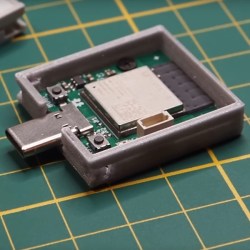 There are a few upcoming cards, too – the dual-port USB-C card project is impressive, giving you two extra USB3-capable USB-C ports! Three different people and companies are working on an LTE card, and I might just make it four, purely because I have an outrageous idea that would be fun to make real. Framework also hasn’t been slacking – we’ve got an Ethernet expansion card, a 3.5mm audio adapter card that fits the upcoming Framework 16 but works everywhere, and we’ve also got firmware updates and rework instructions to enable power saving on the DisplayPort and HDMI cards they’ve already shipped.
There are a few upcoming cards, too – the dual-port USB-C card project is impressive, giving you two extra USB3-capable USB-C ports! Three different people and companies are working on an LTE card, and I might just make it four, purely because I have an outrageous idea that would be fun to make real. Framework also hasn’t been slacking – we’ve got an Ethernet expansion card, a 3.5mm audio adapter card that fits the upcoming Framework 16 but works everywhere, and we’ve also got firmware updates and rework instructions to enable power saving on the DisplayPort and HDMI cards they’ve already shipped.
In that way, USB-C and the Framework laptop are a match made in heaven, and the mechanical standard is reasonably well thought-out. If I were to be designing a laptop or other portable device today, I’d absolutely add a Framework-compatible Expansion Card socket!
Innovation in consumer laptop space seems to be mostly stagnant and improvements superficial, so having a ripe for the taking standard like this on the table is exciting, as even the currently relatively small number of third-party expansion cards makes it super worthwhile as a selling point. Given that MNT Reform has gone all-in on the USB-C in its Pocket edition, it could very well turn out to be a community mod – not that you can’t already plug an Expansion Card into a random USB-C socket, as the cards are fundamentally USB-C compatible!
Framework has also recently announced a video series where they’re going to take a full-sized SD Expansion Card from idea to manufacturing, and I have a suspicion that it won’t be limited to PCB design tutorials. Seeing a company get an actual product through their pipeline, explaining the reasoning behind it, is not the kind of lesson you get every day, and you can’t expect any other laptop company to give you such insights, as it stands.
Reduce, Reuse, Rejoice
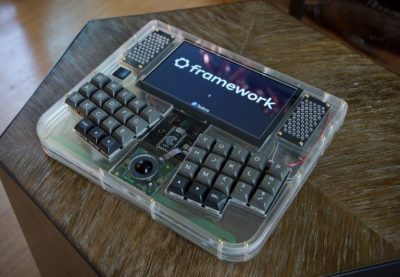 When it comes to repairability, upgradability and hacker-friendliness, there’s an elephant in the room – individual part reuse, from the motherboards and screens, to keyboards and cases. Since the beginning, Framework has promised that you would be able to upgrade your motherboard when they release a new one, and indeed, there’s now 12th generation Intel CPU motherboards available, with 13th gen Intel and even AMD motherboards on the horizon. This is amazing, but what do you do with the old motherboard you now have laying on your desk, which is effectively a full computer in need of a home?
When it comes to repairability, upgradability and hacker-friendliness, there’s an elephant in the room – individual part reuse, from the motherboards and screens, to keyboards and cases. Since the beginning, Framework has promised that you would be able to upgrade your motherboard when they release a new one, and indeed, there’s now 12th generation Intel CPU motherboards available, with 13th gen Intel and even AMD motherboards on the horizon. This is amazing, but what do you do with the old motherboard you now have laying on your desk, which is effectively a full computer in need of a home?
Framework has addressed this from multiple angles – the most fun one was the “motherboards for makers” program, a seed effort where they’ve sent out motherboards to people who described what kind of project they’d like to do. The reality of such an effort is lower-than-100% ROI – plenty of people will put the board on a shelf, and I have to admit that I’ve effectively done the same with the board I got, never using it for the purpose I stated I would. However, we’ve seen a good few prominent projects grace our pages, and my view is that the main achievement of this program has been putting the idea of “you can build things with this mainboard” rather than 100% return on the hardware investment. Something is better than nothing?
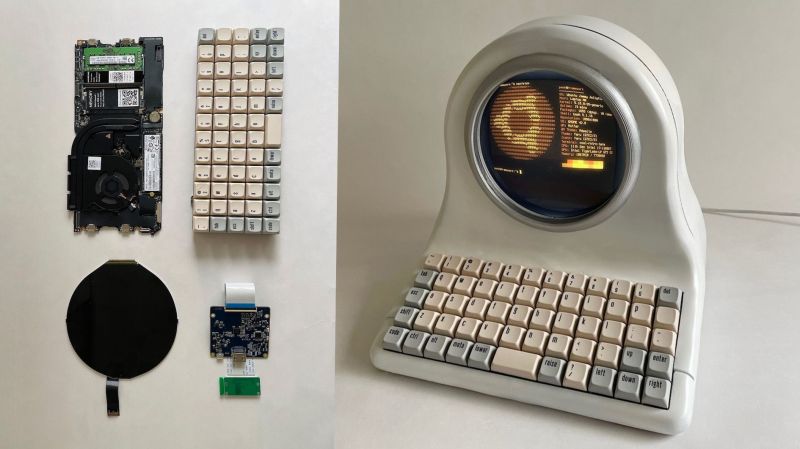
I’ve noticed that Framework hooks into “I’ve built it myself” aspect of maker culture. Even if you’re just printing out a new case for a motherboard, it’s a project that you’re directing, and having a finished project under your belt feels good. With Framework, whenever you decide to upgrade your motherboard, you get a whole computer in return, that’s also a project part, and a seed for a project that you might just bring to reality.
On Hackaday alone, we’ve covered a cyberdeck, a cool-looking handheld, a tablet, a futuristic-looking terminal, a rebuild of venerable Thinkpad 701C, a mechanical keyboard, and all sorts of other devices like this all-in-one. On the Framework Discord server, I’ve just watched someone work on a build where a Framework board is packed together with a PC PSU and a Thunderbolt-connected external GPU for a reasonably powerful yet compact gaming machine. Upgrading such a laptop isn’t just a regular kind of upgrade you can do in the future, it’s a moment you can eagerly await with a special project idea in mind.
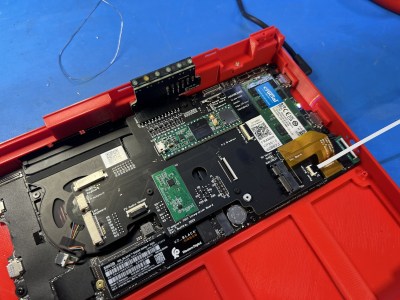
Part reuse has been the area that I’ve focused on – I love such mostly-unexplored niches, and I’ve been building laptop hardware reuse projects long before that. This is where Framework has given free reign to the community, publishing partial schematics focused on external connectors of the board, and following up whenever people had further inquiries. They’ve released DXFs of the motherboard and associated boards, pinout, connector and part sourcing information for third-party boards, notes on the wiring intricacies, even EC sourcecode and a decent amount of sourcecode or libraries for various parts of the ecosystem, and they are quite helpful to all projects seeking to go beyond expansion cards and motherboard reuse. The Framework board has essentially become a kind of high-power x86 CPU module you can use for your project, with all sorts of interfaces you can pull out of USB-C and lower-level onboard ports, and a ready-to-go battery power solution if you need that.
Because of trade secret concerns and subsequent NDAs with the companies Framework has to work with in the x86 platform space, we may never see full Framework laptop schematics – what we hackers have is a 12-page PDF with the high-level board overview and Framework-specific connector schematics. This partial openness is understandable, and, it’s way better than building projects using smuggled schematics that only become available years after the device’s release.
There were a few nuances stemming from the proprietary aspects, that I and others had to reverse-engineer – for instance, Compal screwing up the pinout on the input cover connector symbol using a completely pin numbering different notation than the connector’s datasheet. However, simply probing the board with a multimeter has led to success, and in the end, I’ve successfully developed a RP2040-based controller for the keyboard+touchpad combo of the Framework – which has been a good playground for me to learn QMK, and also a platform for my experiments with HID over I2C, a wonderful technology that I hope I can introduce to you all sometime soon!
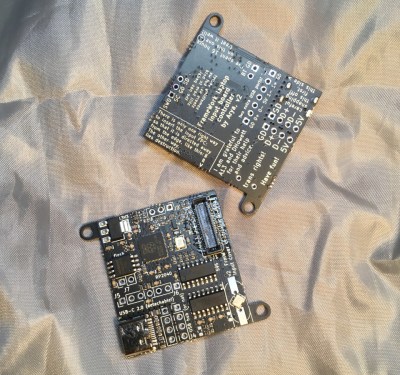 One thing we didn’t see materialize was third-party motherboards – despite us getting info like DXF outlines. However, a few people did start hacking on it, and as someone who talks with other hackers in the Framework community, I know that we might just get a surprise project down the road!
One thing we didn’t see materialize was third-party motherboards – despite us getting info like DXF outlines. However, a few people did start hacking on it, and as someone who talks with other hackers in the Framework community, I know that we might just get a surprise project down the road!
That said, as much as it’d be fun to have such a board, there’s not much demand – all in all, people have been pretty satisfied with the 12th and 13th generation Intel motherboard upgrades. Also, AMD motherboards already getting into the hands of people who have preordered them, and given that, we might just see an influx of projects based on Framework motherboards in the Hackaday Tips line! It won’t be the only influx we see, either.
Bigger, Faster, More Expandable
About a year ago, Framework has announced the Framework 16 – a 16″ gaming/workstation laptop, larger, all-AMD, and with a discrete GPU. It’s no doubt a response to people who wanted something more beefy than the 13″ model, and it also has two standout features that push the Framework’s expandability standard even further – the Input Module ecosystem, and the Expansion Bay, giving you input device modularity and GPU replacements respectively.

The Input Modules, on the other hand, take the 13″ laptop’s single-piece keyboard+touchpad combination, and split it into modules socketed onto a common base, with the individual modules connected over USB or I2C. For a user, this means you can easily add a numpad to your Framework, remove it if you’re numpad-averse, or stack eight numpads in case you suffer from numpad deprival-induced trauma. It also means you can create your own modules that go in the place of the keyboard or the touchpad – from macropads to smartcard readers, and even extra screens! Framework has, once again, provided reference designs, and community members are already manufacturing their own cards, like this RGB LED matrix card that’s already been manufactured and is now in its second revision!
Raising The Bar
Now, this is a lot to say about a two-year-old product, but I guess my background helps. I’ve spent a decade using devices like laptops and phones and then a decade more fixing and improving them, and during that time, I’ve watched them turn more and more into black boxes with knobs to tune the endless stream of entertainment. The difference is especially stark when I compare it to the 8-bit computing years I’ve been taught about, years that raised the generation whose knowledge and advice helped me find my place in the world of hacking and electronics. We’ve had a treasure trove of technological improvements since then, sure, but we’ve lost some core principles that made computers more human-friendly, and accumulated a fair bit of cruft that made the personal computer world feel dull and grey – no matter how bright the everpresent RGB lights shine.
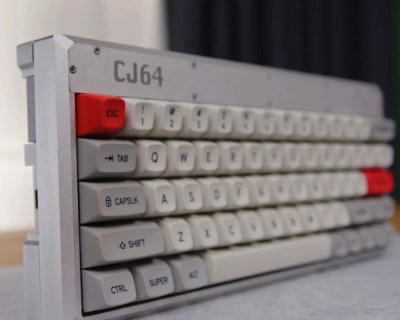 Looking at what Framework has achieved so far, I feel reassured. A lot of the most annoying cruft has been shed here, and you can see people having fun with the concept, driven because they get to improve upon a thing they will be using on the daily, or build something new that helps them live a fulfilling life in this tech-focused world.
Looking at what Framework has achieved so far, I feel reassured. A lot of the most annoying cruft has been shed here, and you can see people having fun with the concept, driven because they get to improve upon a thing they will be using on the daily, or build something new that helps them live a fulfilling life in this tech-focused world.
Just throughout the few last days, I’ve been watching someone on the Framework Discord server build a powerful router out of a Framework motherboard, with PCIe Ethernet cards in both of the M.2 sockets, and a colorful 3D-printed case that makes the project look solid while shielding it from dust. Given the trove of existing mechanical designs you can start with, it’s been an easy project for them to build, and it’s been fun to observe for me too. It warms my heart to see people build their own tech so easily, because ultimately, it isn’t something you can buy – not just the specific device you build, but the fun you have on the way, and the power that it gives you.
The hacker-driven projects I list, aren’t there just for the technical value – each one of them holds a fair bit of joy from the person who worked on it. And that’s, without doubt, because Framework’s focus on the hackability has helped people channel the fundamental desire to play with the technology we use, each hacker imbuing their creation or mod with a piece of their soul. That’s a stark contrast to the soulless machines designed to be used in a certain way for a few years and then discarded – each Framework laptop is a gateway to a Framework laptop-based project, and each Framework project brings yet another hacker into our community.
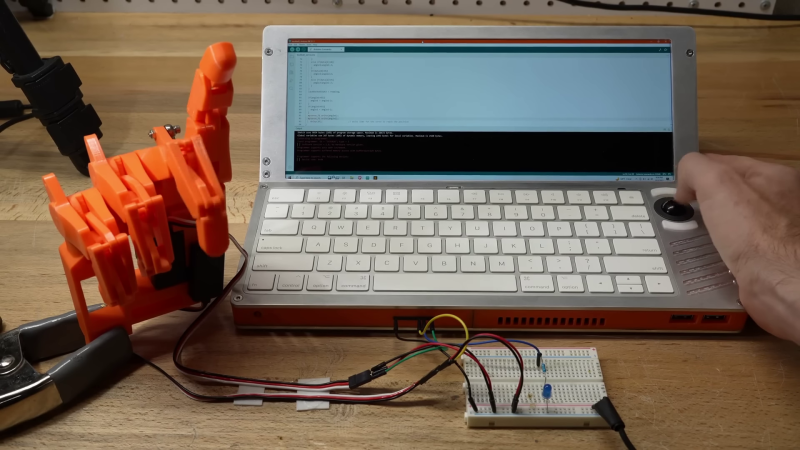
I don’t know if these relatively high standards can nudge other companies to take lead, though we can all hope. I do know how powerful examples of actual success can be when it comes to making the world turn, and it matters that we can highlight a company that’s making large steps in the hacker-friendly direction while maintaining undeniable mass appeal. Sure, you can form an underground movement with repurposed and low-volume tech, but producing hackable things at scale is how you shape a generation, and we could always use a bit more of that.
Framework is, in many ways, an ecosystem ripe to be conquered by the hacking spirit, from upgrades to repairs made simple. I personally can’t wait to see where it goes, and whether its high standards can nudge other companies into a better direction as the repairability, hackability and openness promises come true one by one. The Framework experiment has, without a doubt, paid off, and sets a high standard for hacker community involvement and outreach – one that we haven’t been seeing companies do on such a scale, and can only hope to see more in the future.

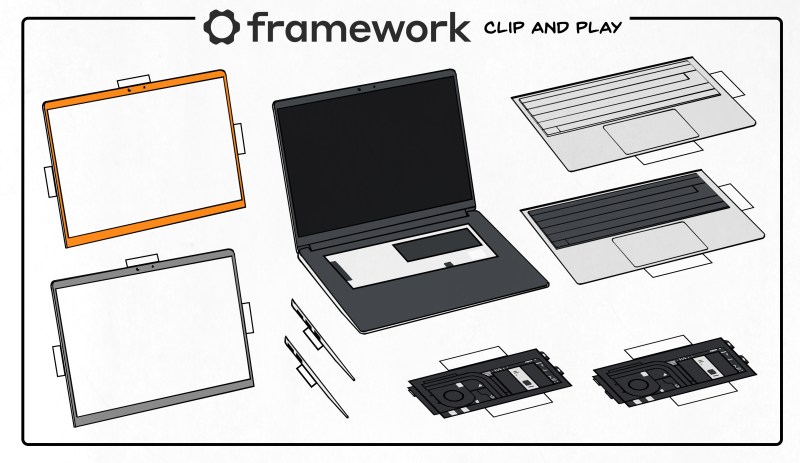















And the point of this article is…?
That’s the second/third paragraph, and, the closing paragraphs too! I see that we have things to learn from Framework’s journey in the hacker realm, even this far, so I’ve decided to tell a story about it.
Welcome to the Scat Immersion Program! Squadiddly-bebop, squadiddly doo!
And the point of your comment is…?
they also gave out main boards to alot of people who had cool ideas and where likely to execute on the projects, thats how i built my cyberdeck, Normally I would have never purchased such an expensive thing to build a cyberdeck but when life gives you a framework main board…
edit: i just read that part in the article
At this point, I am thinking pen and paper
Typewriter, mechanical calculator, mechanical watch, what more could you need?
A mechanical salaried job
I for one need a trackpoint equipped keyboard, I may make one myself someday . . .
Anybody else get CCd when they sent a mass email to everyone who had /applied/ for a maker board, instead of just those who won?
I am very excited to see someone build a trackpoint for the 16″ Framework. I assume you already know, but in case you haven’t seen it, there’s a Reddit for trackpoint builds: https://www.reddit.com/r/TrackPoint_Builders/
I’d love to see Framework take over the ExpressCard standard and update it to include PCIe 5, 6, or 7 and USB 3.x along with widening the connector to the full width of the 54mm slot to put in more PCIe lanes.
ExpressCard 2.0 failed to gain traction due to manufacturer apathy. It supported USB 3.0 and one PCIe 2.0 lane. Unfortunately PCIe 2.0 support was *not mandatory*. It would have been a decent improvement over ExpressCard 1.0’s one PCIe 1.0 lane and USB 2.0.
Some companies (like Samsung) even dragged their feet on implementing ExpressCard 1.0. I had a MPC T2500 (identical to a Samsung X65) made in 2008 with a CardBus slot. 2008! ExpressCard 1.0 was first used on laptops in 2005.
So take ExpressCard over from USBIF and skip version 3.0. Go directly to version 4.0 with PCIe 7.0 or whatever is the fastest that can be crammed into it.
the latest ExpressCard did include USB3, right about it stopped appearing on laptops >,< To me, it feels like the ExpressCard standard never really took off. I have hardly seen peripherals for it while it was out, and the requirements for custom connectors/tooling is a bit meh for me – in contrast, USB-C connectors are here to stay. USB stuff is basically as speedy as PCIe can get, anyway, so chip manufacturers have kind of focused on that instead. It's a fun connector if you think of all the things that a ubiquitous hotplug-able PCIe-capable socket can bring, sure, but I've never really seen good applications for it =( It'd be cool if USB-C had a PCIe altmode and not whatever tf Thunderbolt is, cuz damn, that'd be power at our fingertips, and compatible with modern-day realities too!
Much as I don’t like USB-C (as it seems by design to be a mess of hidden incompatibly even if you follow the spec perfectly! And how many companies actually manage to do that?) it does actually make much more sense for framework than trying to revive a format that the industry rather comprehensively killed long ago. And credit to framework they have actually done it properly (at least in theory all ports work with all the functionality a framework supports, though last I checked some more work on the firmware was required).
Can’t agree with Arya on the connector though – the Cardbus and Express card connectors would be far superior format for the framework modules than USB-C with its excessively compact and flippable format requiring more PCB layers and extras to deal with, the Expresscard connector is much simpler and more sanely spaced so most modules that want to be more than just USB-2.0 device could be made cheaper and simpler than a USB-C version will be, and being much wider footprint should be massively more mechanically durable as well.
There were never many useful peripherals available in ExpressCard, so adding the slot to a laptop didn’t really offer much value to the end user. The end user probably saw significantly more value from having a CardBus slot, since there was an enormous ecosystem of cards to tap into.
Of course, many of those cards were obsoleted or built into the laptop by then (wifi, probably wired ethernet too, possibly an SD slot or something), but that’s why ExpressCard never got much stuff made for it. Most ExpressCards I ever saw were just additional USB ports. I had an ExpressCard-equipped laptop and the only thing I ever put in the slot was a storage tray with a tiny pen and some folded up dollar bills.
The cards that people HAD TO HAVE would be weird industrial stuff, for instance, that never got updated to ExpressCard in the first place. And for those customers, a CardBus slot was a huge value. Plus the old stuff like extra wired ethernet ports, you wanna turn an old laptop into a router and need more interfaces? Cheap CardBus adapters made suitably-equipped machines relevant for such duties long after their ExpressCard-hobbled cousins were useless. A friend of mine ran a Thinkpad PFsense box just like that for yeeeeears. (Yes there were EC/34 ethernet cards, but they weren’t as ubiquitous or as cheap as their CB predecessors.)
I think I agree with Samsung’s logic here. CB was the more useful of the two, well into what should’ve been its technical obsolescence, simply because of the ecosystem around it.
I’m very interested in seeing how the reviews go for the 16 inch. The 13 inch is a cool device, but the lack of a discrete GPU was a no deal for me in my current position – moving around and uprooted a lot means a desktop PC is impractical, and the main problem with gaming laptops is the complete lack of modularity and the truly ugly Gamer Aesthetic. The 6600(?) in the 16 inch won’t blow anyone away, I expect, but if it’s a success we might see some more powerful cards or perhaps even a Nvidia card for that sweet, sweet DLSS.
oh have you considered an eGPU? people have been using those with Frameworks for a while now, to good results, it seems
I appreciate your articles Arya, you can really feel the joy you have for the hacking world in them.
So we heard all the good stuff, what are the main issues with the framework laptops. I remember hearing about them long ago, but figured they wouldn’t last long enough to make getting on worth it. I was clearly wrong in my thoughts that laptops were too bespoke to be able to make a framework to allow continual updating.
Thank you, and, glad I can convey what I’m feeling! ^w^ Hard for me to say on the main issues – I’m a laptop enthusiast, not a laptop reviewer. I guess, the price can be steep for some, they’re not selling in all countries yet, and there’s some hardware bugs, but not at a higher percentage that I’ve seen for other laptops. I’d also guess that it’s not a laptop for everyone, just like any laptop – there’s a reason why companies release multiple models within a generation, with different parameters and all! I’ve never checked on what makes it inferior with regards to other laptops on the market, because I’ve always felt pretty depressed about all the other laptops on the market, so what makes Framework stand out for me is not having the features that tend to make me depressed about laptops, and having the features that make me feel joy =D
I love the concepts of laptop sustainability and re-use that Framework brings to the discussion. But what I cannot stand is the price. I look at the Framework 13 laptop running the latest mid-range Intel Core or Ryzen processor that starts at $850.00 bucks, then I compare that with a $125.00 (including free shipping) refurbished Lenovo ThinkPad T430, i5-3320, 14 inch HD display, 8GGB SDRAM, 256GB SSD, Dual-Band WiFi, USB 3.0, running Windows 10 pro.
Yeah the $125.00 ThinkPad T430 will not run Windows-11 (no Intel TPM in the T430), but it runs any flavor of Linux or xBSD Unix just fine and I can dual-boot Windows-10 Pro and there are lots of hardware upgrades for the T430 I can do myself. Anyway, I normally run Linux Mint Cinnamon or NomadBSD (FreeBSD based) on my laptop. So $850.00 vs $125.00 just to run Windows 11? Nah – I don’t think so. For awhile I’ll still keep one machine around running Windows-11, just in-case. But all the other machines I use will drop Windows 10 as soon as Microsoft stops supporting it. Eventually my plan is to drop Windows all together. I dropped Microsoft Office in favor of LibreOffice long ago.
At a starting price of $850.00 for one Framework 13 laptop I can buy almost seven (6.8) refurbed T430 ThinkPad laptops.
The T430 is 3rd gen Intel, and while those are good machines for some day-to-day tasks, 10 year old Intel 2c4t is seriously weak by modern standards. With AMD, you get proper performance, modern storage options, and it’s way more future-proof than the T430. I don’t care for Windows either, been full-time Linux for three years now and part-time for way more than that, but this 11th gen FrmW just doesn’t sweat at the majority of jobs I throw at it, and the 3rd gen Intel I’ve been driving for six years before that, started getting slow and not up to the tasks I’ve been using it for. The display is way better – “HD” is a bad option! and a decent upgrade is easily $50 if not more! I also don’t have to scrape the bottom of the barrel for a replacement battery like it is with old Thinkpads, battery life is miles better too, and all the new interfaces are just a cherry on the cake. Just buying a better 3rd gen CPUs to upgrade that T430 is going to be a decent chunk of cash. Old machines have their place, but they are slow.
Can’t really compare such an old I5 to a modern CPU in performance or power efficiency, so while I agree you really don’t need all that compute especially if you run Linux for normal desktop tasks if you ever do run into compute limits that old machine will fall flat. But if you never do compiles, renders, media conversion etc you won’t notice it much if at all, at least until the ever growing bloat of the internet crushes the old hardware (something I hope we never get to). And the quality of those older Thinkpad keyboards make them hard to move on from.
Though the battery life improvements for idling along on a more modern CPU should be very meaningful if that ever comes up as well – though as Thinkpads are well designed, with good software support and optimisations where modern hardware can be very lax there so it may not actually work better – you can be fairly sure without any effort a thinkpad will go to lower power states correctly)
I think the words need re-ordering in this sentence “Compal screwing up the pinout on the input cover connector symbol using a completely pin numbering different notation than the connector’s datasheet. “
Great article! I’m very strongly considering a Framework when I finally get a new laptop to replace my trusty 2009/2010 MBPs. I’m currently debating Macbook vs Framework. I don’t do much heavy computing, so the hardware modularity and repairability would be a better deal than the ridiculous performance of the M-series processors.
I just ran across this article that mentioned Framework and the old Project Ara that would be interesting to see reborn again. Framework Phone, anyone?
https://www.techradar.com/phones/project-ara-was-the-best-smartphone-idea-you-never-got-to-try-heres-why-it-deserves-a-second-chance